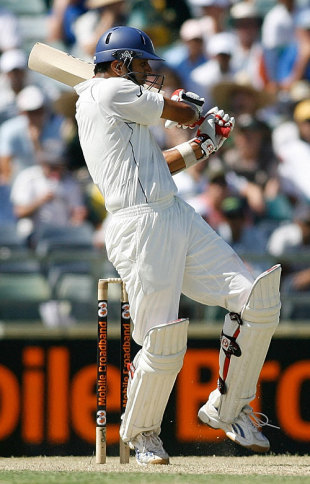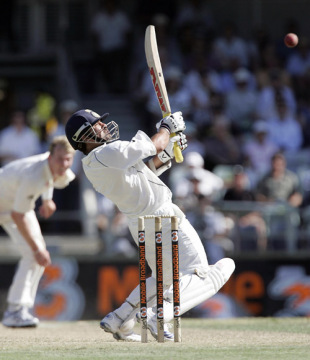
|

The manner in which Dravid has battled his way back, over by over, innings by innings, should be an inspiration to anyone struggling with form
© Getty Images
|
|
| |
It was in keeping with the script of the day that Rahul Dravid played an uncharacteristic swipe to effect his dismissal and tilt the momentum, in fine balance at that point, in Australia's favour. After the misery of Sydney, Perth provided an enthralling and rewarding day of Test cricket when the focus returned to the contest between bat and ball.
It didn't quite pan out as expected, though. The build-up to the Test had been breathless with everyone from the curator to former players to newcomers talking up Perth's restoration to its former fiery glory. The speed gun kept crossing 150 when Brett Lee had the new ball but, one hour into the second session, the field placements told the story.
Mitchell Johnson had gone back to his run-denying line, a foot or two outside the off stump with a seven-two field; Shaun Tait returned to bowl with point on the fence; Ricky Ponting stood at short mid-on to Andrew Symonds' gentle medium-pacers. By tea, Symonds and Michael Clarke were bowling spin at both ends. Even the breeze was blowing in the wrong direction, from south-east instead of south-west.
But drama wasn't lacking. Virender Sehwag announced his return to Tests with a series of swishes that got India off to an explosive start, Brett Lee then bowled an outstanding spell to bring Australia back, only for two batting masters, playing in contrasting manners, to take over.
Rahul Dravid's struggle in the earlier matches has been one of the most fascinating stories of the series. A man of lesser character would have wilted, but the manner in which Dravid has battled his way back, over by over, innings by innings, should be an inspiration to anyone struggling with form. He had the good fortune of being dropped early today but with the innings' progression emerged the man who scored 619 runs in his previous series here.
The manner of his dismissal will dominate the reports tomorrow and it will perhaps grate him the most but in the circumstances and in the context of the match, he played a splendid innings. As always, he was assured against the short ball, either swaying away or getting on the top of the ball and dropping it down, but the key to succeeding on bouncy pitches often lies in how a batsman responds to the full ball and Dravid's driving through the covers and down the wicket was flawless. It would have been a century to cherish and perhaps the anxiety to get to it quickly induced that stroke.
Of course he was indebted to Sachin Tendulkar, who is now batting as well as he ever has. His innings was constructed as much on skill as on cleverness. His greatness is based on balance and versatility and today he displayed both. The Australians had apparently spotted a weakness in his response to the short ball, and it was clear from the beginning not too many would be offered for him to drive. And so he devised his response.
| |
|
|
|
| |
| Something ought to be done about the slow over-rates. Fines have just not worked. Ian Chappell advocates banning the captain but there might be a even better deterrent. Hit them where it hurts the most by docking them for runs. |
| |
A few of his early slashes would fool late-comers into thinking Sehwag was still at the crease but followers of Indian cricket would remember it was Tendulkar who showed the way at Bloemfontein in 2001, when Sehwag was a wide-eyed apprentice. Today, if the ball was short and outside off stump, it was evident that Tendulkar would try to hit over the slips for four. A couple of his slashes were edged but the ball was never in danger of being caught. The best of them, though, was manufactured almost after the ball had passed his nose. A short one from Lee followed him as Tendulkar looked to sway out of the way and when it got too close to him, he brought the bat below the ball and gently directed it over the cordon. It was inventive, deft and touched with genius.
Not until he got to 64 did Tendulkar hit a four in front of square on the offside, and it was a glorious cover-drive played off Stuart Clark, front foot stretching forward, the upper body leaning in to give the stroke force, and the front shoulder rotating to give it direction. Sixteen years ago he had played a lone and glorious hand at this ground as his seniors crumbled around him; this Indian batting line-up is far more solid but, once again, Tendulkar was the guiding light on the day that could have gone horribly wrong for India. A rough decision and a brilliant over from Lee denied him his second successive hundred at the WACA but it wasn't until Dravid's dismissal that the wheel started turning in Australia's favour.

|

Brett Lee was outstanding, bowling in the off-stump channel, the wind blowing across his right shoulder, generating a lovely away curve at good pace
© Getty Images
|
|
| |
Perhaps even the Australians had been misled about the pitch. To add to it, their big weapon, Shaun Tait, failed to fire. Either he was too eager, or too underdone, or perhaps both. He is yet to add variety to his bowling and once the Indians started going they picked him easily for runs. Lee was outstanding, bowling in the off-stump channel, the wind blowing across his right shoulder, generating a lovely away curve at good pace. He could have got Sehwag early, had a catch dropped off Dravid and he alone troubled Tendulkar. Responsibility now sits handsomely on his shoulders.
His dismissal of Laxman in the dying moments of the day gave Australia the edge. At start of the innings, they would have expected to knock India out for under 300. After the experience of the first two sessions, they will take 350. For India, the challenge is to push towards 400.
An excellent day was, however, marred by hopeless over-rates. The Sydney Test was blighted by all sorts of unsavoury incidents but one offence, committed by both teams in the series so far, is the speed at which the bowlers have gone about their job. When India last toured Australia Sourav Ganguly came close to a ban for failing to keep the over-rate up to speed but on this tour the matter hasn't even come on the radar.
A 90-over stipulation was put in place to rein in the West Indians, who, it was argued, were gaining an unfair advantage by bowling their battery of fast bowlers leisurely. The decision to play with four quick bowlers in Perth was Australia's and so was the onus to keep it moving. They were found shockingly lacking. They bowled 12 overs in each of the first two hours, 13 in the third, 14 in the fourth, and the second new ball wasn't due until after ten minutes of the scheduled close of play. That is an unacceptable breach of playing conditions.
Something ought to be done. Fines have just not worked. Ian Chappell advocates banning the captain but there might be a even better deterrent. Hit them where it hurts the most by docking them for runs. See how no-balls have become scarce in Twenty20 after they introduced the free hit.
Sambit Bal is the editor of Cricinfo

